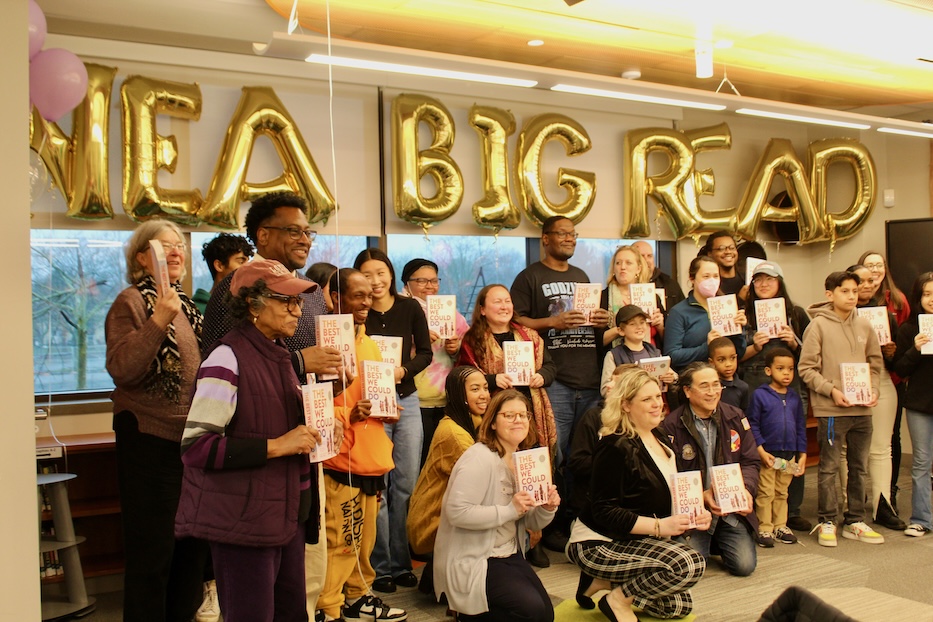
Books | Culture & Community | International Festival of Arts & Ideas | Arts & Culture | New Haven Free Public Library | Arts & Anti-racism
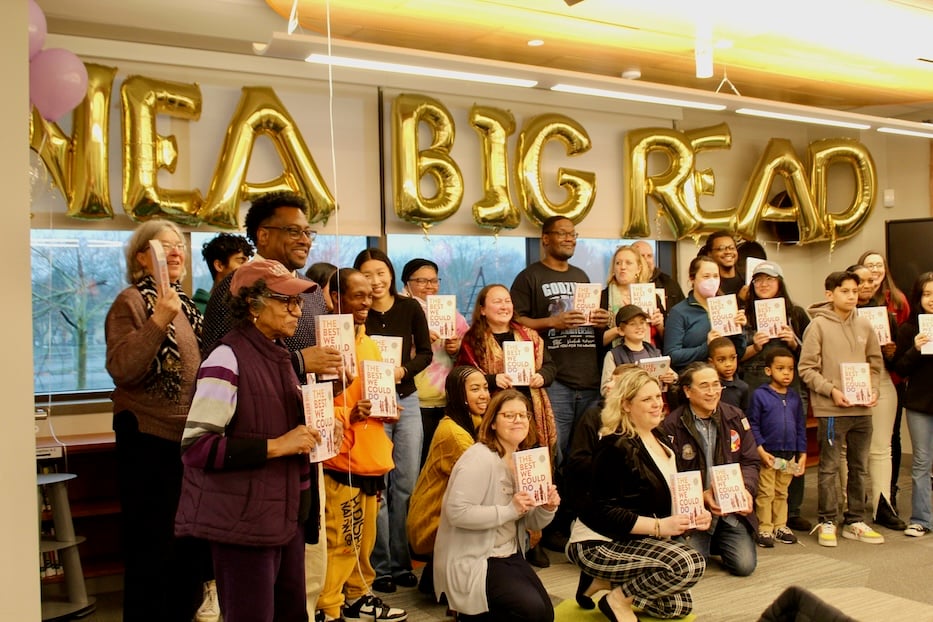
Lucy Gellman Photos.
Growing up in Connecticut, Angelina Li didn't have the words for how white supremacy split her identity in two. At home, she was proud to be Chinese American. At school, she insisted she was actually white. It would be years until she heard the words "model minority myth," and felt something click.
Now, she is working to help other students bust through that myth —and hoping that a graphic novel can help her.
Wednesday night, Li brought her story to the Stetson Branch Library, as the International Festival of Arts & Ideas and New Haven Free Public Library launched this year's NEA Big Read from the building's bright second floor. As rain hammered down on the roof and balloons bobbed beneath the ceilings, attendees celebrated Thi Bui's The Best We Could Do, an illustrated memoir that chronicles her family's journey from Vietnam to the U.S. in the late 1970s.
Roughly three dozen attended despite the wet weather. As it unfolds in New Haven, the Big Read is a collaboration with the National Endowment for the Arts and the NHFPL, with several events between now and the end of June. For the first time this year, the book will also be taught by at least two educators at every New Haven public high school.
"This is about coming to this country and feeling like you have to make yourself smaller, like you have to conform to what's going on here and lose your identity," said Shamain (Sha) McAllister, associate director of education and community impact at the Festival. "These are things we have to talk about. No one is the same, and we shouldn't have to hide one's culture to fit a mold. Food is great when you have all the different ingredients in it, right?"
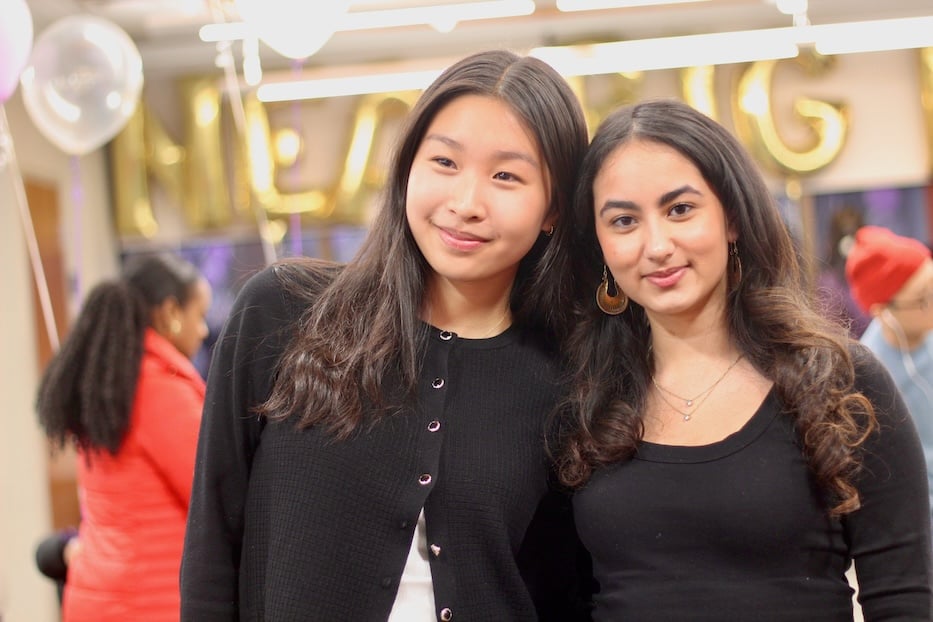
Angelina Li and Simar Soni.
That begins with the novel itself. Published in 2017, The Best We Could Do tells the story of Bui's parents and young family, who became refugees in the 1970s following the Vietnam war and fall of South Vietnam. At the time, Bui was just three, and spent time in between worlds in a refugee camp in Malaysia before ultimately coming to the U.S. What she found was a country that did not always live up to its promise of safety and welcome—especially for people of color.
The result is a powerful and unflinching lesson in 20th century colonialism, war, and displacement that most American students don't get in their history classes. It is also a nonlinear narrative, that begins with the birth of Bui’s son and pedals back in time, reflecting on the fierce love, physical and emotional pain, and toil of motherhood itself.
But the themes—migration, parenthood and family, generational trauma and the harm of whiteness —are not limited to Bui's experience at all.
Both McAllister and anti-racist educator Jennifer Heikkila Díaz, with whom she collaborated closely, saw it as a natural choice for that reason. In 2021, Díaz was able to teach the book as part of a community of practice with 10 teachers in Bridgeport, New Haven, Hartford and Naugatuck and saw firsthand how engaged students were in the material. At the time, a teacher told her that his students couldn’t put it down, she remembered. She's excited to return to it.
"This book resonates," she said. "There's something in it for everybody, even if your story is very different from the author's story. Talk about this book. Engage with people. There's many, many other stories, so go read them. Find them."
.jpeg?width=933&height=622&name=BigRead%20-%201%20(1).jpeg)
Sha McAllister.
Nowhere was that need clearer than during a panel that addressed both the book and the danger of the model minority myth, which in the U.S. has often been used to pit Black Americans against Asian Americans as a tool of white supremacy. Alongside Li, a Harvard-bound senior at the Hopkins School, panelists included Díaz and Bethel High School senior Simar Soni, all in conversation with McAllister.
All three panelists have all been active in curriculum development for House Bill 5282, which will require Connecticut public schools to fold AAPI (Asian American and Pacific Islander) history into their curricula.
Throughout, all three reflected on how their own lived experience made Bui's novel that much more powerful when they read it. Raised in Orange, Li remembered growing up with a "fragmented identity," ashamed of her Chinese heritage at school even as she embraced it at home. In her classes, teachers assumed that "I was that shy Asian girl" who would excel academically, even as she struggled with math and learning English as a second language.
She told her peers that her parents, who are visibly Chinese, weren't her actual parents. By her own admission, "I hated myself for 15 years."
Then she transferred into private school. Suddenly, she was learning a history of migration that her other classes had skipped over entirely. She understood so much more about her parents’ generation and their choice to immigrate, as well as some of the discrimination they faced in the U.S. It was as if someone was sewing her two selves back together.
"I was able to learn why my parents came to the U.S., and why other Asian Americans are in the U.S., but also the history of African Americans and Black Americans," she said. "Once I finally was able to grasp all that knowledge and understand ... this is the reason we're so pit against each other ... I began teaching these classes about immigration and U.S. history."
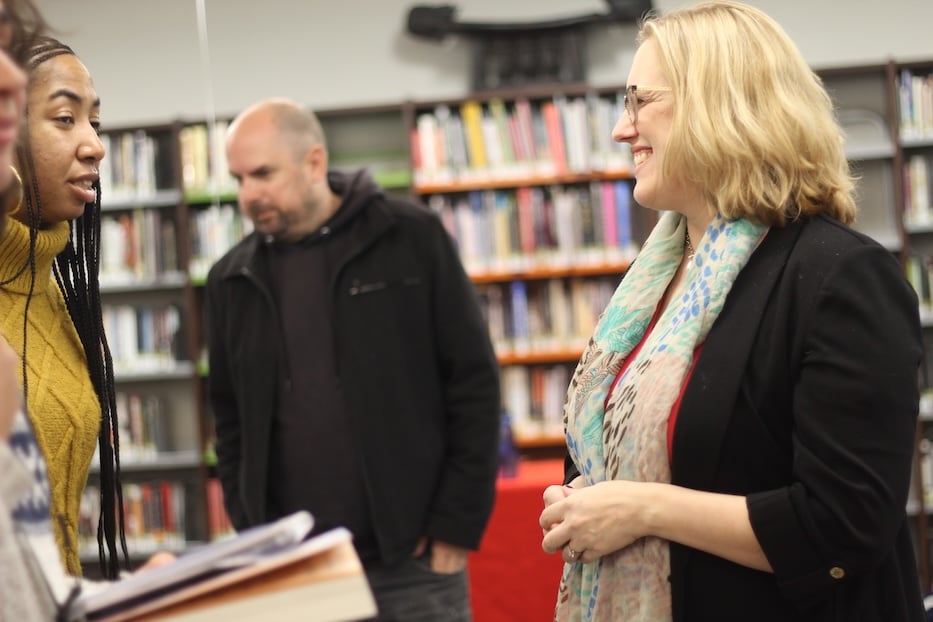
She spread her myth-busting teaching to kids of multiple ages, from first graders and students in Chinese school to her peers in Connecticut high schools. She launched Hearstory, an oral history project focused on AAPI identity. She's now a member of the Connecticut Asian Pacific American Affairs Commission and a student consultant on the Connecticut AAPI Curriculum Lab, a project of the University of Connecticut (UConn).
"It's really about history and telling our stories, but it's also about infusing those diverse perspectives into policy and politics," chimed in Soni, who plans to study PoliSci at the University of Pennsylvania. "I think that it's important for us to have social change and cultural change across social groups, intersectionality in that way, but there also has to be systemic change."
As a fellow organizing member of Hearstory, Soni remembered her own battle with internalized racism. Growing up in Bethel, where almost 70 percent of the population is white, she often felt pressure to assimilate and fit in. At school, she would tell students that her name was Summer, not Simar. In middle school, she watched as teachers encouraged students to debate whether colonizers were in the wrong, or actually innovators.
"I remember, I was always like, 'That's .., that's not ... that's not okay," she said. Now that she's working with Hearstory, she is proud of her identity—and constantly reminds others that Asian Americans are not a monolith, and no single experience should be accepted as the cultural norm.
Díaz, who for years has worked with the Asian and Asian American Studies Institute at UConn, also stressed how the model minority myth hurts not only Asian Americans, but all marginalized peoples. She turned the clock back to the 1980s and 1990s, when she was just a kid growing up Korean American in Los Angeles.
During those years, L.A. saw the killing of Latasha Harlans, a 15-year-old Black girl, by Korean store owner Soon Ja Du, and the beating of Rodney King by L.A. Police Department officers who were not charged, despite the presence of video footage. Díaz was in seventh grade at the time of the L.A. riots that followed.
"I remember seeing the city burning, right?" she recalled. "And then seeing how the systems were set up to protect certain parts of the city—the white parts of the city—while Koreatown was burning, while South Central L.A. was burning. The model minority myth—that hurts Asians, but it also hurts all of us, right? And particularly the Black community."
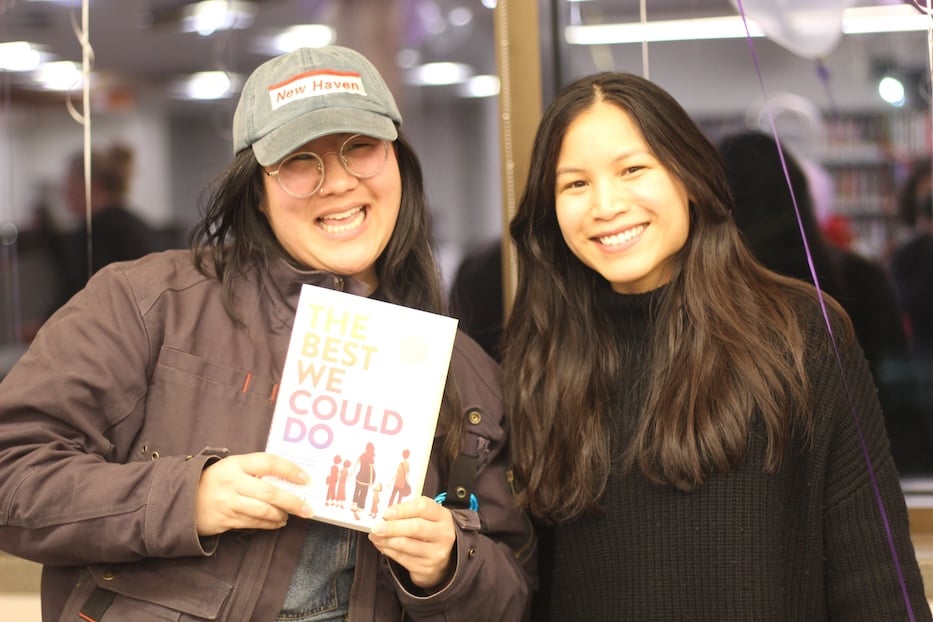
Readers Esther Chiang and Michelle Phuong Ho.
The focus on the book comes at a significant time for public education and AAPI history in Connecticut, Díaz added. By fall 2025, Connecticut schools will be required to integrate AAPI history into their curricula, although "each district is going to come up with their plan," so it may look different from one town to the next. Díaz credited years of legislative advocacy, largely led by Black and Latino young people for Connecticut Public Act 19-12, as paving the way.
She was also quick to shout out the people who have helped steer legislative advocacy and curriculum development at the state, including UConn Professor Jason Chang and Yale lecturer Quan Tran.
It's long overdue, Díaz continued. Even well-meaning teachers may stock their classrooms with books that appear diverse, but all have some version of the same up-by-the-bootstraps immigrant narrative. That doesn't help immigrants and other people of color, Díaz said. It hurts them by perpetuating harmful stereotypes and obfuscating the very real hurdles that are tethered to whiteness and capitalism.
"Our schools are built in very white supremacist ways, that keep out our communities and keep out our families, and ask people to leave their cultures and their identities at the door," Díaz said. "To leave all that out and act like it doesn't exist."
She encouraged attendees to both read the book and bring it into their communities, something that the Festival and NHFPL are also trying to do. In addition to copies at all five library branches, the NHFPL has all-ages microbranches dedicated to migration and diaspora, featuring authors from Vietnam, Afghanistan, Palestine, Iran and Central and Latin America.
In addition, the Festival also has several Big Read events, from an author talk next week to discussions around legacy, family ties, and the Great Migration.
"This is a book that needs to be read," Díaz added. "And not just by Asian Americans. By everyone."

